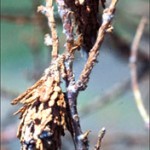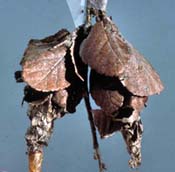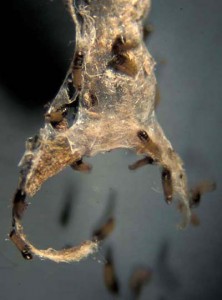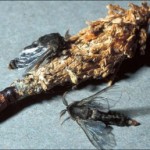- View or print the PDF version: Bagworms, E-1802
The small, silk weaving that resembles a Christmas tree ornament on your favorite tree or shrub is not decoration. These bags protect the caterpillars, or larvae, pupae, female adults and eggs of bagworms (Order Lepidoptera Family Psychidae, Fig. 1).
Bagworms attack trees and shrubs including evergreens such as arborvitae, cedars, cypress, junipers, pines and spruce; and broadleaved plants such as apple, basswood, black locust, boxelder, elm, honey locust, Indian hawthorn, maple, various oaks, persimmon, sumac, sycamore, wild cherry and willow.
Although bagworms are not abundant every year, once a plant is infested the insect becomes a persistent problem unless controlled. Texas has several species of bagworms, including Astala edwardsi, A. confederate, Tyridopteryx meadi, T. ephemeraeformis, Cryptothelea gloveri, Oiketicus abbotii and O. townsendi.
Each species’ slightly different habits and life cycles affect the timing of control measures. Infestations, which may not be noticed at first, can defoliate trees and shrubs, and kill these plants if left unchecked.
The bagworm ( Thyridopteryx ephemeraeformis) found on most evergreens lives in east-central Texas, from the Oklahoma state line to the Gulf Coast. Each species has one generation per year. Eggs are laid in the fall and hatch in the spring. Caterpillars grow throughout the summer and pupate in August or September. After a 3-week pupal period, the adult moths emerge. After mating, the females deposit their eggs and die.
The live oak bagworm (O. abbotii) is abundant in the south-central part of the state, along the Gulf Coast to the Louisiana state line. Caterpillars can be found throughout the spring and summer. Most of the moths emerge in April and May, but some appear through October. Larvae may hibernate during the winter and resume feeding in the spring before pupation. Hibernated eggs may hatch as early as February. A species of the desert bagworm (O. townsendi) is found from El Paso to Alpine and in the Trans-Pecos area of Texas. These bagworms usually pass the winter as large larvae, which feed a little in the spring before pupating in April or May. Moths emerge from April throughout
the summer. Their growth and life changes are influenced by rainfall and season.
Biology and Habits
The most easily identified feature of bagworms is the tough, portable, silken case they build to live in. The silken texture of the bag is hidden and strengthened by layers of leaves, twigs and bark fragments arranged in a crosswise or shingle fashion. Different species use different plant materials to make their bags. The worm expels refuse through a small opening at the narrow, lower end of the bag and uses a wider opening at the top as a door to crawl out to feed or repair its bag.
Newly hatched bagworm caterpillars are about 1/25th of an inch long (Fig. 2). As the larvae hatch, they spin single threads of silk and attach to adjacent limbs or plants, where they begin building their own silk bags; they carry the bags upright as they move.
Young larvae drifting on the silk thread may spread the infestation to new host plants.
As the caterpillars grow, the bags becomes more elongated. At maturity, caterpillars may be 3/4 to 1-inch long; the bags hanging from plants are 1-3/4 to 2 inches long and more than 1/2-inch wide. Most species carry their bags along twigs and foliage with their feet or by an attached silk thread. A larva closes its bag’s upper opening before each of the molts between developmental stages and before winter hibernation
or pupation.
Adults emerge after the pupal stage. The adult male, which resembles a small moth (Fig. 3), is sooty black in color, and has clear wings with a 1-inch span and feathery antennae. The males leave their bags through the lower end and fly to seek females, leaving their pupal skin protruding from the bottom of the bag.
The adult female looks like a maggot, with no functional eyes, legs or antennae. Her body is soft and yellowish-white. The wingless females emerge only halfway and wait to mate with the males. Once mated, the adult female deposits 400 to 1,000 eggs in the empty pupal case (Fig. 4) in her bag before dropping to the ground and dying.
Control
Birds, insect parasites and insect predators are natural enemies of bagworms. Bird predation and insect parasitism can help keep bagworm outbreaks brief. However, natural enemies often can’t prevent the bagworms from damaging plants.
Handpicking bagworms off the plants is the cheapest way to control them, particularly in the winter months. Pick off all of the bags and destroy or discard them. Eggs in bags thrown on the ground will hatch in the spring and develop into larvae that could reinfest the plants.
If handpicking isn’t practical or safe, use insecticide spray. Apply insecticide soon after bagworm eggs have hatched or while the larvae are small and feeding. Determine the right time for treatment by collecting bags in late winter and keeping them in a container out of sunlight. Once the caterpillars hatch from the bags in the container (Fig. 2), apply insecticide to plants.
Chemical control is not as effective when the caterpillars close their bags to molt or pupate. In most areas, insecticides applied in April, May and June are effective. Use insecticides containing acephate (Orthene®), Bacillus thuringiensis var. kurstaki, carbaryl (Sevin®), pyrethroids (bifenthrin, cyfluthrin, cypermethrin, lambda-cyhalothrin, permethrin, etc.), spinosad, azadirachtin, neem oil, malathion, pyrethrins or insecticidal soap. Use spray equipment that gives complete coverage of all foliage. Hire a professional exterminator if you do not have adequate equipment.
Related Resources
- Bagworm slideshow in PDF
- Bagworm Moths of the Western Hemisphere, Bulletin 244, by D.R. Davis (1964), Smithsonian Institution, United States National Museum. Washington, D.C. 233 pages.
- The Bagworms of Texas. [Search for “bagworms”] Bulletin 382. F. M. Jones, and H. B. Parks. 1928. Texas AgriLife Research, College Station, TX. 36 pages.
- Texas AgriLife Extension publications can be found on the Web at the AgriLife Bookstore.
Pesticide Use
All pesticides are potentially hazardous to human health and the environment. Pesticide users are legally required to read and carefully follow all directions and all safety precautions on the container label. Because label instructions are subject to change, read the label carefully before buying, using and disposing of any pesticide.
Regardless of the information provided in an Extension publication, always follow the product’s label. When in doubt about any instructions, contact the pesticide seller or the manufacturer listed on the label for clarification. Keep all pesticides in their original labeled containers and stored away from children. Never pour leftover pesticides down a drain.
Disclaimer
The information on this page is for educational purposes only. Reference to commercial products or trade names is made with the understanding that no discrimination is intended and no endorsement by the Texas AgriLife Extension Service is implied.
Author
Bastiaan M. Drees, Professor and Extension Entomologist, The Texas A&M System
Acknowledgments
This publication is a revision of L-1802, Bagworms, by Philip J. Hamman, former Extension entomologist. The author is grateful for review comments by Carlos Bogran, John Jackman and Scott Ludwig.




